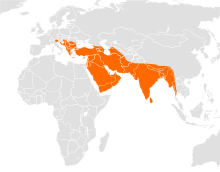Canis aureus
| Golden jackal Temporal range: 1.9–0 Ma – Recent |
|
|---|---|
 |
|
| Scientific classification | |
| Kingdom: | Animalia |
| Phylum: | Chordata |
| Clade: | Synapsida |
| Class: | Mammalia |
| Order: | Carnivora |
| Suborder: | Caniformia |
| Family: | Canidae |
| Tribe: | Canini |
| Genus: | Canis |
| Species: | C. aureus |
| Binomial name | |
|
Canis aureus Linnaeus, 1758 |
|
| Subspecies | |
|
7, see text |
|
 |
|
7, see text
The golden jackal (Canis aureus) is a canid native to southeastern and central Europe, Asia Minor, the Middle East and South Asia. It is listed as Least Concern on the IUCN Red List, due to its widespread range in areas with optimum food and shelter. It is a social species, the basic social unit of which consists of a breeding pair and any offspring it might have. The golden jackal is very adaptable, being able to exploit many foodstuffs, from fruit and insects to small ungulates. As of 2005, MSW3 recognises 13 subspecies, though genetic studies published in 2015 revealed that six supposed golden jackal subspecies living in Africa were members of a separate species, Canis anthus, reducing the number of actual golden jackal subspecies to seven.
Although similar to a small grey wolf, the golden jackal is distinguished by a more slender build, a narrower, more pointed muzzle, a shorter tail, and a lighter tread. Its winter fur also differs from a wolf's by its more fulvous-reddish colour. Despite its name, the golden jackal is not closely related to black-backed or side-striped jackals, being instead more closely related to grey wolves, coyotes, and Ethiopian wolves. It is capable of producing fertile hybrids with both grey and African wolves.
Golden jackals feature prominently in Middle-Eastern and Asian folklore and literature, where they are often described as tricksters analogous to the fox and coyote for European and North American tales, respectively. In contrast, in Europe it is largely viewed in a negative light as a filthy scavenger, whose presence is indicative of environmental degradation.
...
Wikipedia

